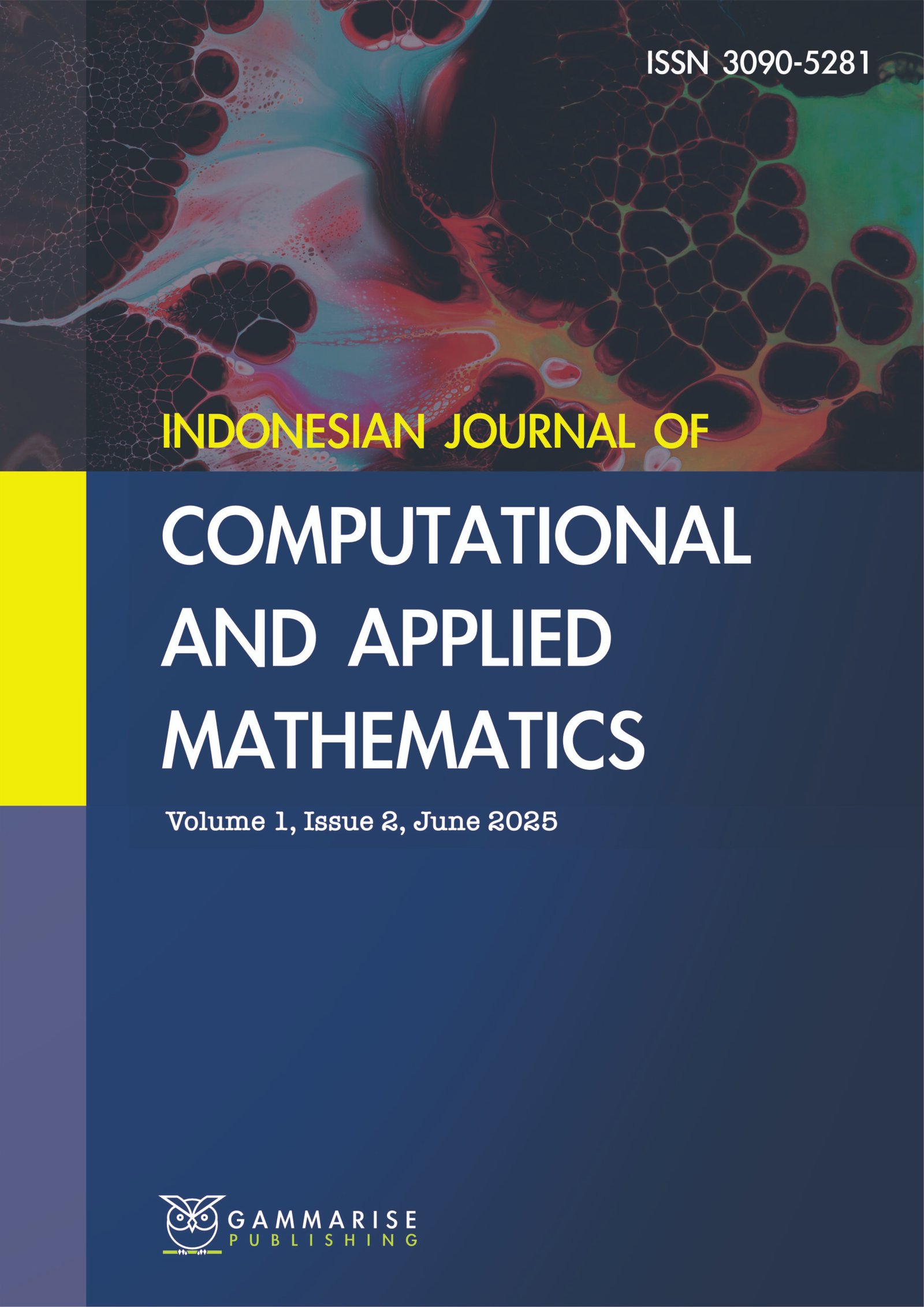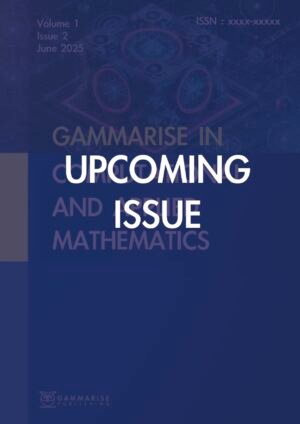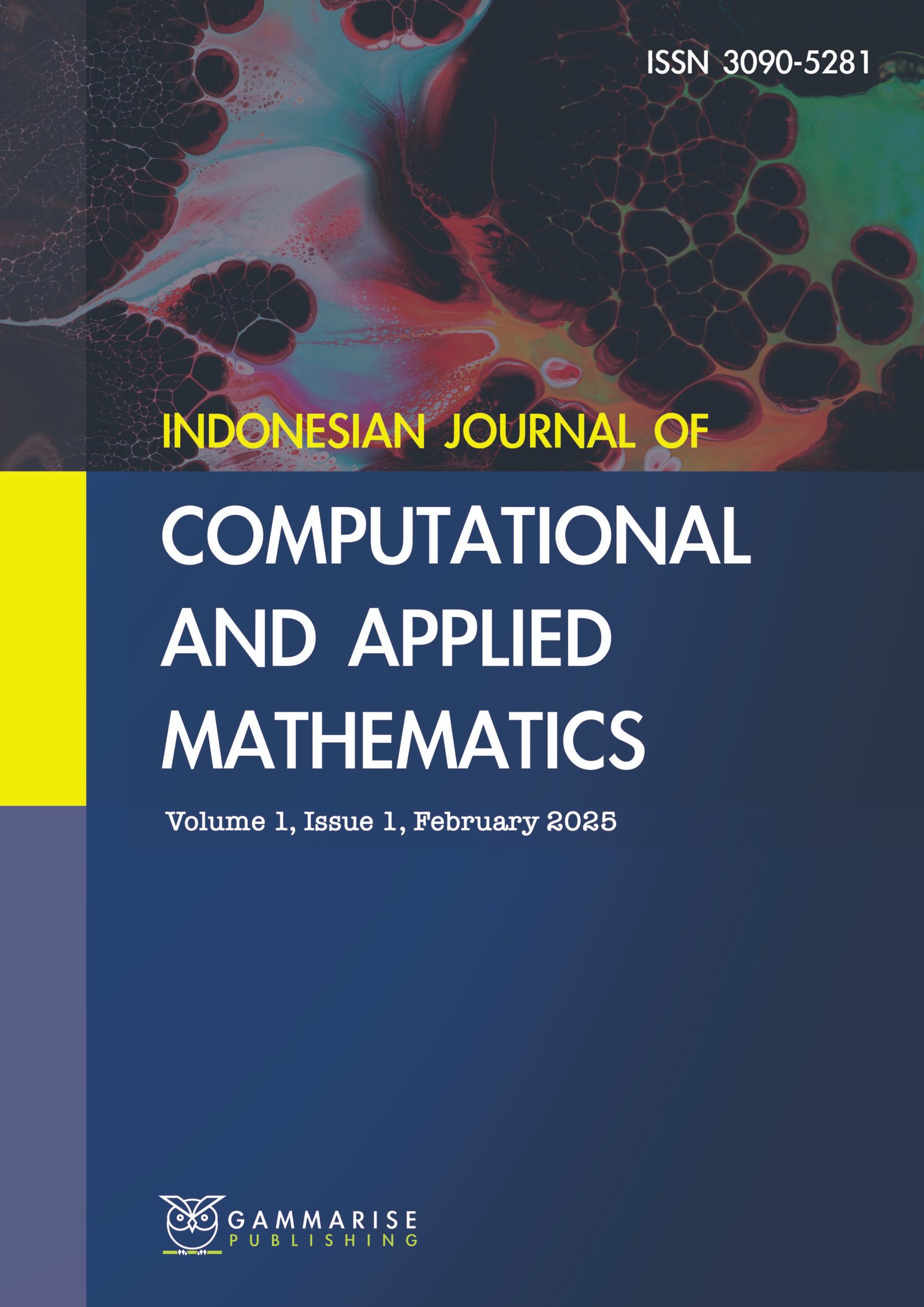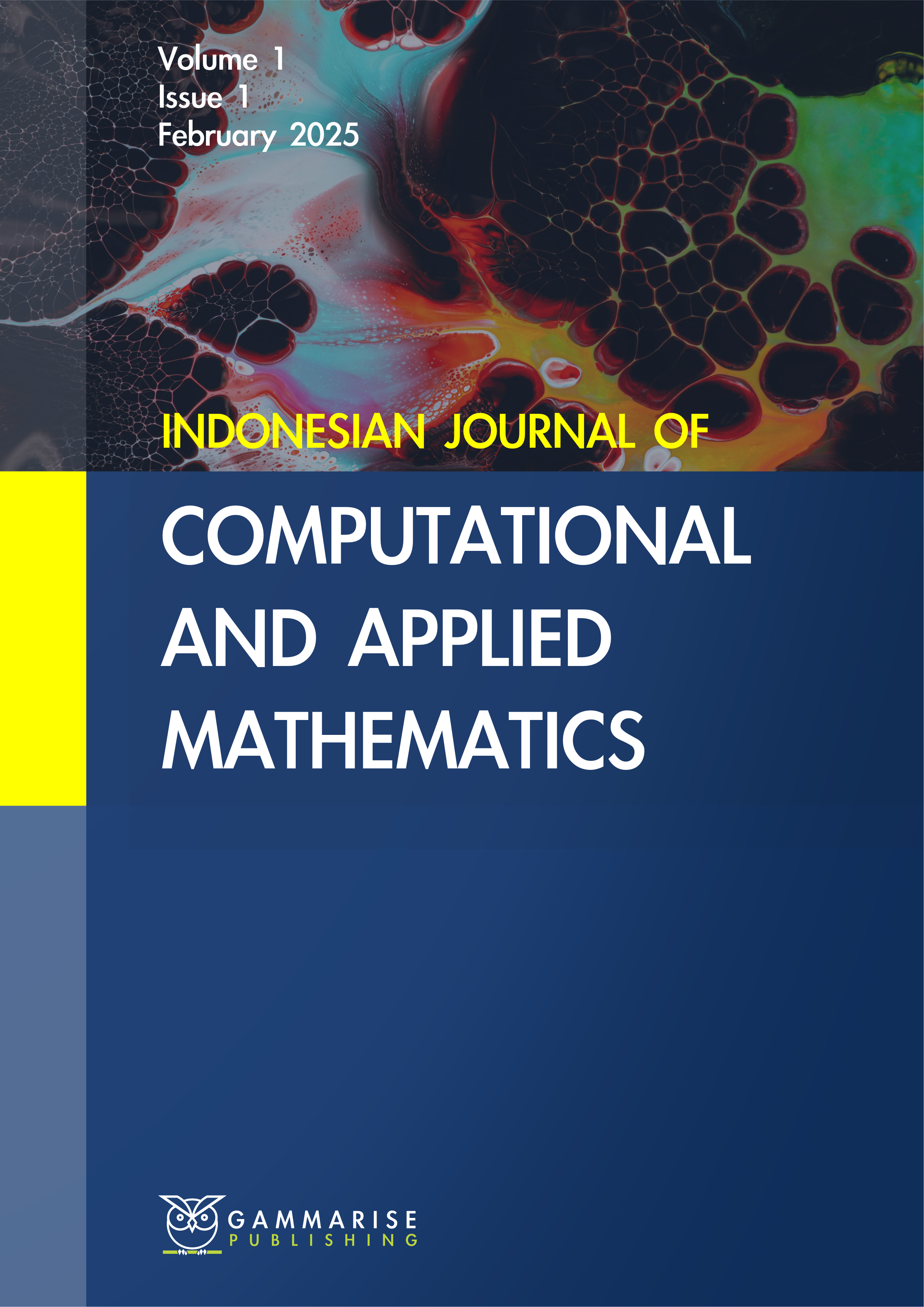Journals
-
Indonesian Journal of Computational and Applied Mathematics
ABOUT THE JOURNAL
Indonesian Journal of Computational and Applied Mathematics is a peer-reviewed, international journal committed to supporting this pursuit by offering an open-access platform for researchers, academics, and professionals in applied mathematics and computational sciences. We welcome original research that introduces fresh perspectives, innovative techniques, or advancements in computational frameworks relevant to various scientific and engineering fields. We aim to bridge the gap between theoretical developments and practical applications by fostering interdisciplinary collaboration and knowledge exchange.
JOURNAL SCOPES
Indonesian Journal of Computational and Applied Mathematics covers a broad spectrum of topics at the intersection of mathematics, computation, and applied research. We invite submissions in areas such as:
Mathematical modeling and simulation involve developing mathematical frameworks to represent real-world systems and using computational methods to analyze their behavior under various conditions. This interdisciplinary research integrates mathematical theories, numerical algorithms, and computer simulations to study complex physics, engineering, biology, and economics phenomena. Models can be deterministic or stochastic, relying on differential equations, statistical methods, or machine learning techniques. Simulations enable researchers to predict outcomes, optimize processes, and test hypotheses in a controlled virtual environment, reducing experimental costs and risks while enhancing scientific understanding and technological innovation.
Research in Computational Algorithms and Optimization focuses on developing efficient algorithms to solve complex mathematical and real-world problems by optimizing resource use, computation time, and accuracy. This field integrates techniques from numerical analysis, machine learning, operations research, and high-performance computing to tackle challenges in diverse domains such as engineering, finance, logistics, artificial intelligence, and scientific simulations. Key areas of study include convex and non-convex optimization, metaheuristic algorithms (e.g., genetic algorithms, particle swarm optimization), combinatorial optimization, and large-scale data-driven approaches. Advancements in this field enable faster and more precise decision-making, improving efficiency in healthcare and transportation industries.
Numerical Methods and Scientific Computing is a field that focuses on developing, analyzing, and implementing algorithms to solve mathematical problems that arise in science and engineering. It combines mathematical theory, computational techniques, and software development to approximate solutions for complex problems that may not have analytical solutions, such as differential equations, optimization, linear algebra, and data-driven modeling. This field is crucial in simulations, data analysis, and large-scale computations across various disciplines, including physics, engineering, finance, and machine learning. Advances in numerical methods enhance the accuracy, stability, and efficiency of computational models, enabling researchers to tackle real-world problems that are computationally intensive.
"Machine Learning and AI in Mathematics" is an interdisciplinary field that leverages artificial intelligence techniques, particularly machine learning, to solve mathematical problems, discover new patterns, and enhance computational efficiency. It encompasses applications such as symbolic reasoning, theorem proving, optimization, and numerical analysis, enabling AI to assist in conjecture generation, equation solving, and high-dimensional data modeling. Machine learning methods, including neural networks and reinforcement learning, are increasingly used to automate mathematical proof verification and explore unsolved problems. This synergy between AI and mathematics advances pure and applied mathematics and drives progress in physics, engineering, and data science.
Financial Mathematics and Quantitative Economics is an interdisciplinary field that applies mathematical models, statistical techniques, and computational methods to analyze and solve complex financial and economic problems. It encompasses risk management, asset pricing, portfolio optimization, derivative pricing, and econometrics, using tools from probability theory, stochastic processes, and optimization. This field is crucial for data-driven financial markets, banking, insurance, and economic policy decisions. Integrating advanced quantitative methods with economic theory enables professionals to model financial systems, assess risks, and develop investment and economic growth strategies.
Data Science and Statistical Applications involve using mathematical and computational techniques to extract insights, make predictions, and inform decision-making from structured and unstructured data. Data science integrates statistics, machine learning, programming, and domain knowledge to analyze large datasets, uncover patterns, and develop predictive models. Statistical applications provide the theoretical foundation for data analysis, ensuring rigor in hypothesis testing, probability modeling, and inferential statistics. They drive healthcare, finance, marketing, and artificial intelligence advancements, enabling data-driven decision-making and innovation across industries.
Mathematical-based Signal and Image Processing involves applying advanced mathematical techniques to analyze, manipulate, and interpret signals and images for various engineering and scientific applications. It leverages concepts from linear algebra, Fourier analysis, wavelet transforms, probability theory, and optimization to enhance signal clarity, compress data, detect patterns, and extract meaningful information. This approach is fundamental in medical imaging, telecommunications, remote sensing, and artificial intelligence, where precise and efficient processing of signals and images is crucial for decision-making, automation, and technological advancements.
Computational Mechanics and Engineering Applications is an interdisciplinary field that integrates numerical methods, physics-based modeling, and computer simulations to analyze and solve complex engineering problems. It encompasses finite element analysis (FEA), computational fluid dynamics (CFD), structural mechanics, material modeling, and multi-physics simulations. By leveraging high-performance computing, artificial intelligence, and data-driven techniques, this field enables the optimization and innovation of engineering designs across various industries, including aerospace, automotive, civil engineering, and biomedical engineering. Advances in computational mechanics enhance predictive capabilities, improve efficiency, and support the development of next-generation engineering solutions.
Bioinformatics and Computational Biology are interdisciplinary fields that combine biology, computer science, mathematics, and statistics to analyze and interpret biological data. Bioinformatics focuses on developing algorithms, databases, and computational tools to manage and process large-scale biological datasets, such as genomic sequences and protein structures. Conversely, computational biology involves modeling and simulating biological systems to understand complex biological processes, such as gene regulation and protein interactions. Together, these fields play a crucial role in advancing research in genomics, drug discovery, personalized medicine, and systems biology by leveraging computational techniques to uncover insights from biological data.
JOURNAL INSIGHTS
Time to First Decision
Review time
Submission to acceptance
Acceptance to publication

Vol. 1 Issue 2: 2025
We accept at least five articles for the upcoming issue in June 2025.

Vol. 1 Issue 3: 2025
We accept at least five articles for the upcoming issue in October 2025.
JOURNAL IDENTITY
Journal Name
:
Indonesian Journal of Computational and Applied Mathematics
Editor-in-Chief
:
Hasan S. Panigoro
Abbreviation
:
Indo. Comp. Appl. Math.
E-ISSN
:
3090-5281
Review Process
:
Single Blind Review
Frequency
:
3 issues per year (February, June, October)
Language
:
English
DOI prefix
:
https://doi.org/10.64182
Indexing
:
Google Scholar
Publisher
:
Gammarise Publishing
License
:
CC-BY-ND
-
Indonesian Journal of Theoretical and Applied Sciences
The Gammarise in Theoretical and Applied Sciences is an interdisciplinary, peer-reviewed journal that publishes cutting-edge research in theoretical and applied sciences. It covers various scientific disciplines, including physics, chemistry, biology, mathematics, engineering, and computer science. The journal is committed to promoting the integration of theoretical advances with real-world applications, encouraging submissions that push the boundaries of scientific inquiry while addressing practical challenges. Researchers, academics, and practitioners contribute original research articles, reviews, and case studies that offer insights into the underlying principles of scientific phenomena and innovative applications in industry, technology, and healthcare. Gammarise Journal of Theoretical and Applied Sciences aims to foster a deeper understanding of the natural world while supporting the development of solutions that impact society and advance scientific knowledge.
-
Indonesian Conference Proceedings
Indonesian Conference Proceedings is a publication portal dedicated to disseminating high-quality research articles originating from conferences and scientific seminars. This proceeding serves as a platform for researchers, academics, and professionals to share their latest findings and advancements in various fields of study. By maintaining rigorous peer-review standards and ensuring accessibility, Indonesian Conference Proceedings aims to foster scholarly exchange and contribute to the global body of knowledge.
-
Indonesian Journal of Educational Research and Review
ABOUT THE JOURNAL
Indonesian Journal of Computational and Applied Mathematics is a peer-reviewed, international journal committed to supporting this pursuit by offering an open-access platform for researchers, academics, and professionals in applied mathematics and computational sciences. We welcome original research that introduces fresh perspectives, innovative techniques, or advancements in computational frameworks relevant to various scientific and engineering fields. We aim to bridge the gap between theoretical developments and practical applications by fostering interdisciplinary collaboration and knowledge exchange.
JOURNAL SCOPES
Indonesian Journal of Computational and Applied Mathematics covers a broad spectrum of topics at the intersection of mathematics, computation, and applied research. We invite submissions in areas such as:
Mathematical modeling and simulation involve developing mathematical frameworks to represent real-world systems and using computational methods to analyze their behavior under various conditions. This interdisciplinary research integrates mathematical theories, numerical algorithms, and computer simulations to study complex physics, engineering, biology, and economics phenomena. Models can be deterministic or stochastic, relying on differential equations, statistical methods, or machine learning techniques. Simulations enable researchers to predict outcomes, optimize processes, and test hypotheses in a controlled virtual environment, reducing experimental costs and risks while enhancing scientific understanding and technological innovation.
Research in Computational Algorithms and Optimization focuses on developing efficient algorithms to solve complex mathematical and real-world problems by optimizing resource use, computation time, and accuracy. This field integrates techniques from numerical analysis, machine learning, operations research, and high-performance computing to tackle challenges in diverse domains such as engineering, finance, logistics, artificial intelligence, and scientific simulations. Key areas of study include convex and non-convex optimization, metaheuristic algorithms (e.g., genetic algorithms, particle swarm optimization), combinatorial optimization, and large-scale data-driven approaches. Advancements in this field enable faster and more precise decision-making, improving efficiency in healthcare and transportation industries.
Numerical Methods and Scientific Computing is a field that focuses on developing, analyzing, and implementing algorithms to solve mathematical problems that arise in science and engineering. It combines mathematical theory, computational techniques, and software development to approximate solutions for complex problems that may not have analytical solutions, such as differential equations, optimization, linear algebra, and data-driven modeling. This field is crucial in simulations, data analysis, and large-scale computations across various disciplines, including physics, engineering, finance, and machine learning. Advances in numerical methods enhance the accuracy, stability, and efficiency of computational models, enabling researchers to tackle real-world problems that are computationally intensive.
"Machine Learning and AI in Mathematics" is an interdisciplinary field that leverages artificial intelligence techniques, particularly machine learning, to solve mathematical problems, discover new patterns, and enhance computational efficiency. It encompasses applications such as symbolic reasoning, theorem proving, optimization, and numerical analysis, enabling AI to assist in conjecture generation, equation solving, and high-dimensional data modeling. Machine learning methods, including neural networks and reinforcement learning, are increasingly used to automate mathematical proof verification and explore unsolved problems. This synergy between AI and mathematics advances pure and applied mathematics and drives progress in physics, engineering, and data science.
Financial Mathematics and Quantitative Economics is an interdisciplinary field that applies mathematical models, statistical techniques, and computational methods to analyze and solve complex problems in finance and economics. It encompasses risk management, asset pricing, portfolio optimization, derivative pricing, and econometrics, using tools from probability theory, stochastic processes, and optimization. This field is crucial for data-driven financial markets, banking, insurance, and economic policy decisions. Integrating advanced quantitative methods with economic theory enables professionals to model financial systems, assess risks, and develop investment and economic growth strategies.
Data Science and Statistical Applications involve using mathematical and computational techniques to extract insights, make predictions, and inform decision-making from structured and unstructured data. Data science integrates statistics, machine learning, programming, and domain knowledge to analyze large datasets, uncover patterns, and develop predictive models. Statistical applications provide the theoretical foundation for data analysis, ensuring rigor in hypothesis testing, probability modeling, and inferential statistics. They drive healthcare, finance, marketing, and artificial intelligence advancements, enabling data-driven decision-making and innovation across industries.
Mathematical-based Signal and Image Processing involves applying advanced mathematical techniques to analyze, manipulate, and interpret signals and images for various engineering and scientific applications. It leverages concepts from linear algebra, Fourier analysis, wavelet transforms, probability theory, and optimization to enhance signal clarity, compress data, detect patterns, and extract meaningful information. This approach is fundamental in medical imaging, telecommunications, remote sensing, and artificial intelligence, where precise and efficient processing of signals and images is crucial for decision-making, automation, and technological advancements.
Computational Mechanics and Engineering Applications is an interdisciplinary field that integrates numerical methods, physics-based modeling, and computer simulations to analyze and solve complex engineering problems. It encompasses finite element analysis (FEA), computational fluid dynamics (CFD), structural mechanics, material modeling, and multi-physics simulations. By leveraging high-performance computing, artificial intelligence, and data-driven techniques, this field enables the optimization and innovation of engineering designs across various industries, including aerospace, automotive, civil engineering, and biomedical engineering. Advances in computational mechanics enhance predictive capabilities, improve efficiency, and support the development of next-generation engineering solutions.
Bioinformatics and Computational Biology are interdisciplinary fields that combine biology, computer science, mathematics, and statistics to analyze and interpret biological data. Bioinformatics focuses on developing algorithms, databases, and computational tools to manage and process large-scale biological datasets, such as genomic sequences and protein structures. Conversely, computational biology involves modeling and simulating biological systems to understand complex biological processes, such as gene regulation and protein interactions. Together, these fields play a crucial role in advancing research in genomics, drug discovery, personalized medicine, and systems biology by leveraging computational techniques to uncover insights from biological data.
JOURNAL INSIGHTS
Time to First Decision
Review time
Submission to acceptance
Acceptance to publication

Vol. 1 Issue 2: 2025
We accept at least five articles for the upcoming issue in May 2025.

Vol. 1 Issue 3: 2025
We accept at least five articles for the upcoming issue in August 2025.

Vol. 1 Issue 4: 2025
We accept at least five articles for the upcoming issue in November 2025.
JOURNAL IDENTITY
Journal Name
:
Indonesian Journal of Computational and Applied Mathematics
Editor-in-Chief
:
Hasan S. Panigoro
Abbreviation
:
Indo. Comp. Appl. Math.
E-ISSN/P-ISSN
:
xxxx-xxxx/xxxx-xxxx
Review Process
:
Single Blind Review
Frequency
:
3 issues per year (February, June, October)
Language
:
English
DOI prefix
:
https://doi.org/10.xxxxx
Indexing
:
Google Scholar
Publisher
:
Gammarise Publishing
License
:
CC-BY-ND


